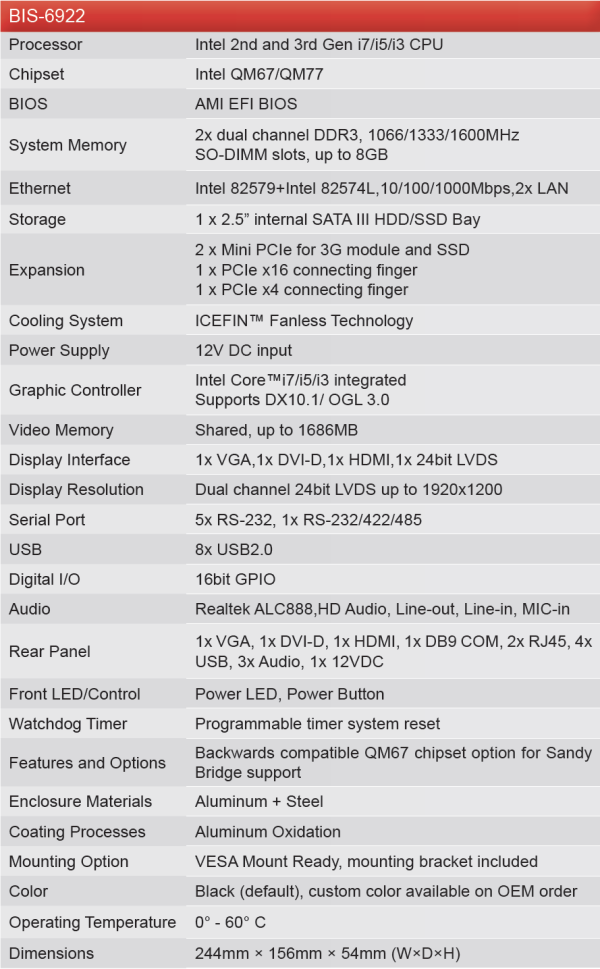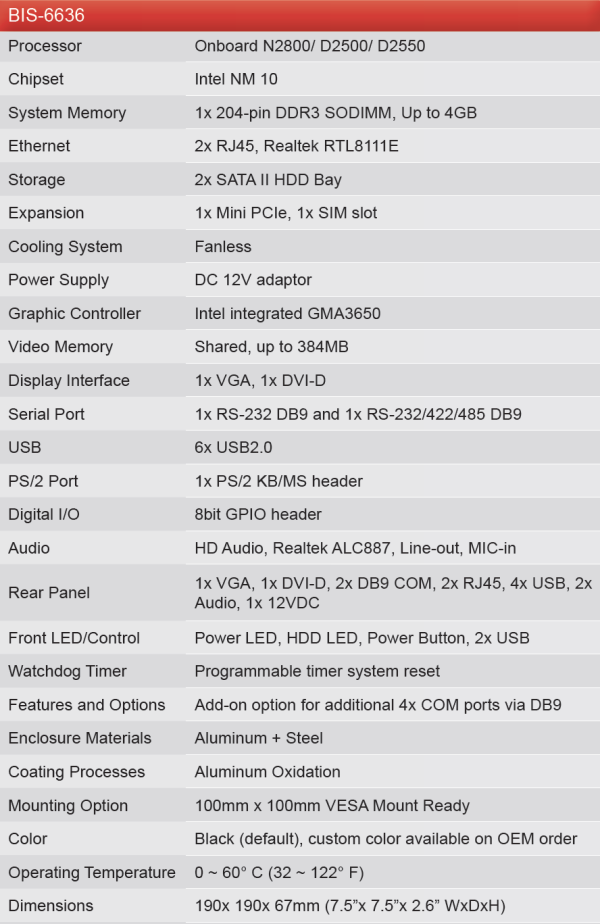Habey Launches Fanless BIS-6922 and BIS-6636 Computers for Industrial Applications
by Ganesh T S on November 19, 2012 12:00 PM EST- Posted in
- Industrial PC
- Passive Cooling
- Habey
Pursuant to our coverage of Aleutia's Relia fanless industrial PC, we received feedback from readers to provide more coverage for the industrial / embedded PC space. In this market, reliability and ruggedness are prime concerns. Habey USA (part of the NORCO group) has been in the industrial PC space since 1991. Recently, they have introduced two fanless PC models, one satisfying the requirements of the higher end market (where a lot of computing power is required), and the other for specialized embedded applications where the processing power provided by the Atom lineup is more than enough.
BIS-6922
The BIS-6922 is Habey's high-end offering with support for both Ivy Bridge and Sandy Bridge CPUs, using the QM77 / QM67 chipsets respectively. The units are passively cooled with Habey's custom ICEFIN technology. The motherboard itself has 2 SO-DIMM slots, two GbE LAN ports and a 2.5" HDD / SDD bay. In terms of expansion slots, we have 2x mini-PCIe, 1 x PCIe x16 and 1 x PCIe x4 connectors. Two simultaneous displays can be driven with the VGA, DVI-D, HDMI and 24-bit LVDS intefaces.
Pricing varies from $416-455 for the barebones version (board and chassis), based on the quantity purchased. Full systems (including CPU, RAM and storage) are priced around $995 for an i3, $1195 for an i5 and around $1250 for an i7 CPU. Detailed specifications are provided below.

BIS-6636
The BIS-6636 is a small form factor Intel Atom based system with dual NICs and up to 6 COM ports. Cedar Trail's PowerVR SGX545 GPU coupled with the VXD and VXE decoder and encoder engines allow Habey to advertise this unit for digital signage and NVR (networked video recorder) applications amongst other things. In terms oS support, we have drivers for Windows 7, Windows 7 Embedded and also embedded Linux OSes such as Timesys Fedora.
Pricing information is not available yet. Detailed specifications are provided below.

















18 Comments
View All Comments
MadMan007 - Monday, November 19, 2012 - link
Looking at the third picture for the BIS-6922 the PCIe connectors seem to be along the left side of the motherboard, one complete x4 and one complete x16. My question is, how is one supposed to use them? First, the PCIe x16 is blocked by a heatpipe. Also, there is little to no clearance between the connectors and the chassis side, so I don't see how a PCB riser would work but maybe one would be thin enough. Maybe there's a flexible riser...ok, either way, where do you mount the card? There isn't an external slot for anything with outputs, but even for internal cards there isn't a mounting mechanism...not very sturdy for industrial use. I looked on Habey's website quickly and didn't find anything under accessories.HabeyUSA - Monday, November 19, 2012 - link
There are two mini-PCIe slots on the board, one on the top, one on the bottom. If you need additional expansion or need full size slots, you can use the gold finger (PICMIG standard) that you see on the left side of the board. The nice thing about the board used in this system (MITX-6922) is that it is expandable to accommodate more than one full size PCIe slot with a raiser (passive backplane). However, the BIS-6922 case is not able to take full advantage of the expansion capabilities of the board to to reasons you've pointed out. To utilize the expansion feature of the MITX-6922 board, a different fanless case or 2U case is required to accommodate this setup, which Habey USA does offer depending on the needs of the application or project.MadMan007 - Monday, November 19, 2012 - link
Quick manufacturer reply, great! I did miss the mini-PCIe slot shown in the picture. I understand that making one motherboard for different enclosures or use needs makes sense, thanks for explaining.HabeyUSA - Monday, November 19, 2012 - link
The mini PCIe slot is the white connector towards the top center of the board that has the bar code on top of it. There's also one on the underside as well as an additional SO-DIMM slot and a SIM card slot.DuckieHo - Monday, November 19, 2012 - link
No internal shots of the BIS-6636?DanNeely - Monday, November 19, 2012 - link
Just 1xMiniPCIe it seems. There's not much room for anything else though; atom only gives a total of 4 lanes to play with. the miniPCIe took 1; the twin realtek ethernet is probably taking 1 lane per port, and the RS232/GPIO ports/hardware watchdog controller is probably consuming the 4th.HabeyUSA - Monday, November 19, 2012 - link
Sorry, this is just a pre-release (for the BIS-6636). A full release with additional pictures and video will follow in the next week or two. Stay tuned!DuckieHo - Monday, November 19, 2012 - link
I just notice the BIS-6636 is running Realtek RTL8xxxx.... would have liked to see Intel NICs instead.Everyone should note that the GMA3650 is really just a licensed PowerVR SGX545. Intel/PowerVR have only provided a Win7/8 32-bit GPU driver and will probably never provide any other video card drivers. That means you can only use basic generic drivers for Windows 64-bit, XP, and any other OS.... so that means no hardware acceleration and low-resolutions for Linux or 64-bit OSes.
HabeyUSA - Monday, November 19, 2012 - link
Our BIS-6630 is a very similar model using dual Intel® 82574 Gigabit Ethernet ports. You are correct about the GMA 3650, however we have a solution for Linux users in place and will release more information about it when our official release for the BIS-6636 drops in the next week or two. It really is some pretty exciting stuff and it addresses the graphics issue of the GMA 3650 on a Linux platform.HabeyUSA - Friday, November 30, 2012 - link
We've just shot a quick video of the full HD graphics on a Fedora based OS. We were able to get 1920x1080 Resolution and play full HD videos with no problems. Take a look! https://www.youtube.com/watch?v=U-UcU1YtxRE